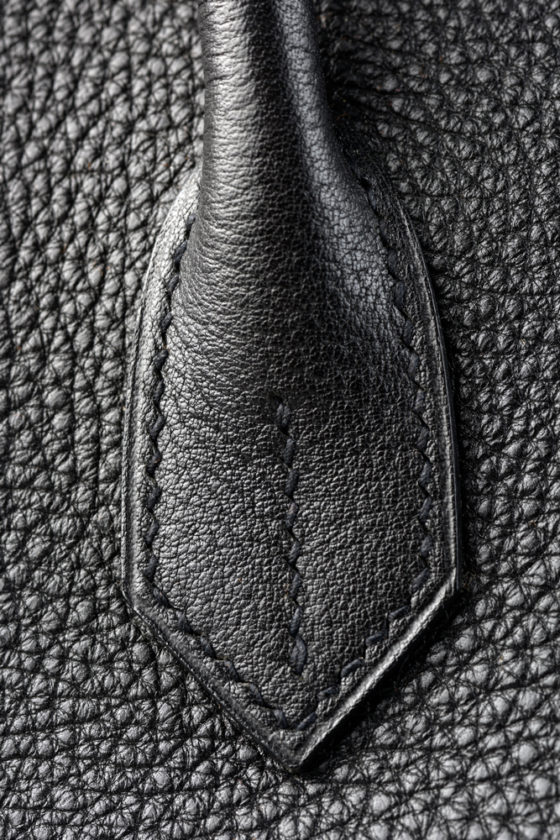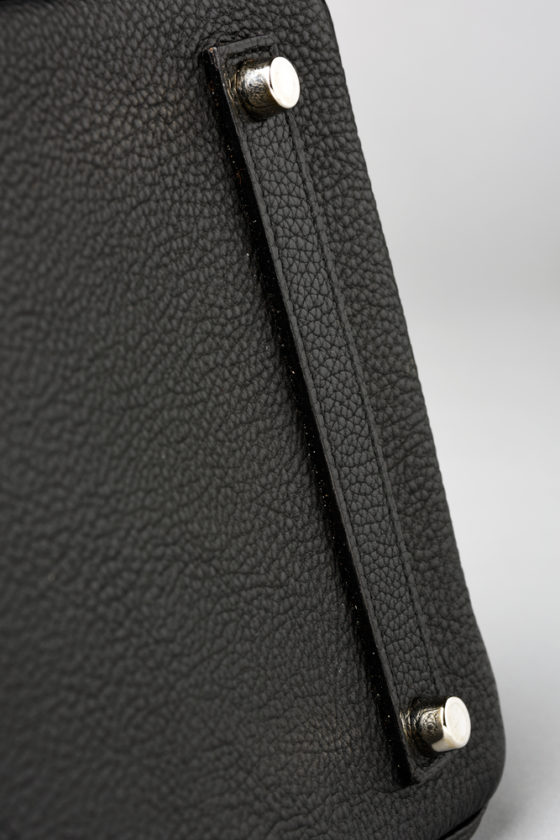Design piracy, the blatant copying of another’s designs, is akin to counterfeiting even without affixing a fake designer label. Design piracy has become common in the United States as fashion companies try to cash in on the demand for high-style designer looks at affordable prices.
The rise to fame of individual designers began with couturier Charles Frederick Worth, who was the first to create labels bearing his name in the early 1860s. Worth’s labels authenticated his exclusive designs—as does an artist’s signature on a painting―but it also became an appealing target for forgers. The examples shown here are from Chanel, Dior, and Birkin, but the problem of fakes and knockoffs is prevalent throughout the industry today.
Fakes or Copies?
This distinction is not as clear-cut as one might think. Many forms of copying, some authorized and some illegal, occur in the fashion industry. After World War II, licensed copies made couture more widely available and contributed to the postwar resurgence of the couture industry, but variations in quality raised questions about authenticity. Unscrupulous dealers would sell couture samples to manufacturers who then produced unauthorized copies, which would also be copied, and so on . . . creating a spiral of declining quality, a practice that continues today.
France, Italy, and the United Kingdom have strict laws against copying a unique fashion design, but there are still no such laws in the United States. While appreciating bargain prices, most people do not realize that the proceeds of much of this counterfeiting goes to fund illegal child labor, organized crime, and even terrorism.
The Cost of Fakes
Wearing cheap replicas of more expensive brands ought to bolster a wearer’s self-image, but research done by scientists at the University of North Carolina at Chapel Hill and at Duke University suggests otherwise. In a blind test, they found that people who thought they were wearing counterfeit designer sunglasses were more likely to cheat on tests (even when the sunglasses they were wearing were actually real). They tested their results in a variety of ways, and it seems that the very fact that someone thought they were wearing knockoffs triggered dishonesty.
What’s the Harm?
Luxury brand manufacturers are aggressively trying to fight the growing problem of counterfeiting and copyright piracy. Consumers should know that counterfeit goods may pose health and safety risks; for example, fake Dior sunglasses offer no actual UV protection and are not shatterproof. They also compromise the legitimate rights, revenues, and reputation of designers and manufacturers. Most people do not realize that proceeds of this counterfeiting may go to fund international child labor, terrorism, and organized crime.
Chanel Suits
Copy Chanel Suit
This suit was obviously copied from the Chanel design, but its origins are a bit unclear. It bears the ILGWU label (International Ladies Garment Workers Union), but it was not authorized by Chanel. It is evident that this copy was made by a competent manufacturer.
At first glance the silhouette is similar, but the wool is of a lesser quality, and the houndstooth is a larger pattern. The grosgrain ribbon trim and buttonholes are machine stitched. The lion’s-head buttons differ from those on the original, and the cuff buttons bear the iconic (but misleading) interlocking CC of Chanel. The lining is acetate rather than silk.
Conclusion? It’s complicated! The design of this suit suggests an authorized copy, but the label, fabric, and buttons do not.
Copy of a Chanel houndstooth suit; ca. 1971
Collection of Claire B. Shaeffer
Genuine Chanel Suit
This suit is from the spring/summer 1971 Chanel collection, the first released after the death of Coco Chanel in January of that year. An iconic design that defines Chanel’s style, it is made with superb craftsmanship and materials, including high-quality houndstooth double-cloth wool with wool trim and three-piece sleeves that vent at the wrist. Its unique double button holes and lining, a silk plain weave, are hand sewn. The dangling chain is gilt, as are the simple, flat buttons.
The twenty-nine-inch skirt is slightly flared with two inverted pleats in the front and back. It has a silk, plain-weave lining with four panels to the waist; horizontal skirt hangers inside at the sides; a silk, four-panel stay at the top of pleats to prevent sagging; a metal zipper on the left back seam; and two coat hooks at the top.
Chanel houndstooth suit
Navy and cream wool; 1971
Collection of Claire B. Shaeffer
It is sometimes difficult to see the difference between fine and fake couture, but the quality of the materials is always a dead giveaway.
Fabric
The genuine Chanel suit (left) is made from a wool double-cloth, which is much heavier in weight than the copy (right). Can you see how the heavier cloth allows the genuine Chanel to hold its shape much better than the lighter-weight wool in the copy?
Hermès Birkin Bag
A Birkin is Born
The popular lore that surrounds the origin of the Hermès Birkin bag is part of its appeal. The story goes that in 1984 Jean-Louis Dumas, the CEO who revived the flagging fortunes of the Hermès company in the late 1970s, was on an airplane with British film actress Jane Birkin. He observed that her open-top bag was spilling its contents as she put it into an overhead bin and suggested that he design something better suited to her travel needs. They collaborated to create a practical bag that has become a fashion icon.
Birkin Mania
The Birkin bag quickly became a fashion sensation. Very expensive and purportedly limited in quantity, the bag was coveted by celebrities and the fashion elite. Its success was boosted by an ingenious marketing campaign and mythology that it was available by waitlist only. As one fashion insider remarked, “The best way to create enormous demand for something is to tell a woman that she cannot have it.” Decades later, collectors continue to vie for access to the most highly prized versions of Birkin bags, which are made in various sizes, from 25cm to 55cm.
Today a basic Birkin bag sells for $10,000 to $15,000 while those made from exotic leathers sell for $30,000 to $60,000. Custom and vintage bags are also in high demand, and now most major auction houses hold a handbag sale several times a year. In 2016, a matte white Diamond Himalaya Niloticus crocodile “Birkin 30” with 18k white gold and diamond hardware was sold by a private Asian collector for $300,168 at Christie’s, Hong Kong, making it the most expensive handbag ever sold and a prime target for counterfeiters.
The Hermès Birkin bag is a highly coveted and exclusive handbag. This authentic bag, distinguishable by its high-quality leather, beautiful stitching, stamped gold logo, proper feet, and correct zipper, is a classic version of the iconic design. Today, this bag retails for approximately $13,000.
Genuine Hermès Birkin bag
Black box leather with palladium hardware, 35cm
Courtesy of Createursdeluxe
Most fake Birkins are easily recognized when seen next to an authentic example. This one, however, is considered a “Super Fake” because it is nearly indistinguishable from an original. Owned by the wife of a former sports celebrity, the bag was consigned to a luxury reseller. It had even passed through “Spa Hermès,” where it was sent for cleaning but was not detected as a fake. The leather, stitching, and stamp are almost perfect. However, in this case, it is the incorrect shape of the feet that give it away. This bag has been retained by the astute reseller to prevent it from recirculating in the marketplace.
Counterfeit bag in the style of Hermès Birkin
Black box leather with palladium hardware, 35cm
Private collection
Ostrich is a luxury leather, well known for its softness, flexibility, and durability. It is also known for its distinctive pattern of “spores,” the bumps or vacant quill follicles across the skin. Ostrich requires an intricate, specialized, and time-consuming tanning process, which is why it is so expensive.
This bag is considered an “exotic” and would retail for approximately $35,000 if it were authentic. In this case, the clear giveaway is in the spores. Hermès hammers them down to make them flat, whereas the fake bag has bumps that protrude from the skin.
Counterfeit bag in the style of Hermès Birkin
Navy ostrich leather with gold hardware, 40cm
Courtesy of an anonymous lender
How do you tell if your Birkin is real?
- Quality of the leather. Experienced collectors can feel, and sometimes even smell, a fake. Exotic skins are faked more often because they are more costly and consumers are not as familiar with what the skins should look and feel like. Genuine Hermès leather is extremely soft. Some resellers say that counterfeits may have an odd smell because of harsher chemicals used to treat the leather.
- Stitching and thread. 99 percent of fakes are stitched with nylon or polyester thread. Genuine bags are stitched with a beeswax-coated linen thread throughout. If you turn a Birkin inside out, the interior stitching should be just as good as that on the exterior.
- Logo. The gold stamp of the logo should be clean, crisp, evenly applied, and centered. All genuine Hermès bags have an accent over the second “è.” On genuine Birkins, the stamp is usually located close to the top edge of the bag; many counterfeiters place the stamp too low.
- Zipper. The inside pocket has a zipper made by Riri, the only supplier used by Hermès. These zippers have distinctly shaped teeth and pulls. The zipper pull is horizontal to the teeth; it should not hang down.
- Locks. A distinctive feature of the Birkin bag, the lock is often the dead giveaway for a fake. Look at the font of the Hermès logo on the bottom of the lock. It should always be clean and crisp. On an original bag, the lock number will match the number on the accompanying keys. If a bag is made of exotic leather like ostrich and crocodile, the lock body will be covered in the same exotic leather, hiding any markings.
- Hardware imprints. The font will always be clean and crisp; the fonts on more recent bags are very thin. As a general rule, the metal used by Hermès is incredibly resistant to tarnish.
- Feet. The feet on a real Birkin are distinctly shaped studs that cannot be unscrewed. Fake bags often have missing feet.
Dior Sunglasses
Dior has a long history of setting fashion trends, and these sunglasses are no exception. The Dior “So Real” sunglasses were introduced in summer 2014 and quickly became the hot new trend in eyewear with their architectural lines and sophisticated flair. Virtually every fashion influencer was seen and photographed wearing the sunglasses. The acetate frame is available in several colors, as are the mirrored lenses. These sunglasses can only be purchased in Dior boutiques and retail for approximately $595.
Christian Dior “So Real” sunglasses
Black acetate with black metal details
Courtesy of Maison de Christian Dior
Seen on countless celebrities, models, fashion editors, and bloggers, the Dior “So Real” sunglasses soon became the eyewear accessory that everyone wanted. They inspired countless knockoffs that were marketed by dozens of major retailers as well as outright counterfeits that were sold to unsuspecting consumers who thought they were buying authentic Dior sunglasses. These are aptly referred to as Dior “Faux Real” sunglasses by fashion insiders.
Counterfeit Christian Dior “So Real” sunglasses
Courtesy of Maison de Christian Dior
Bibliography
Elie, Ariele. Faking It: Originals, Copies, and Counterfeits. The Museum at FIT online exhibition. http://exhibitions.fitnyc.edu/faking-it/
Tonello, Michael. Bringing Home the Birkin: My Life in Hot Pursuit of the World’s Most Coveted Handbag. New York: HarperCollins, 2009.

























